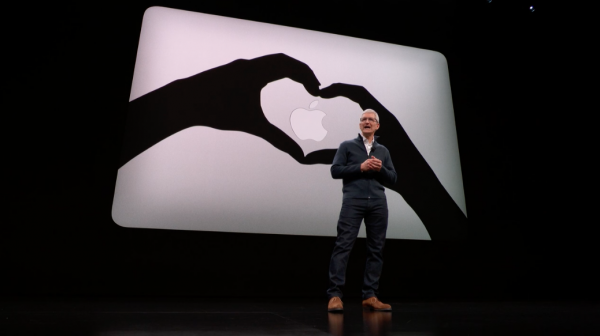
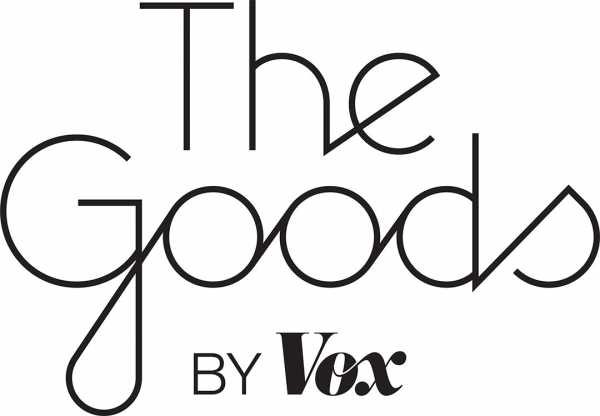
The sexiest 38-second clip the world has ever seen is called “Lightness.” In it, a mysterious rectangle pushes to get free of a piece of blue silk. The rectangle opens like a mouth, and the blue silk sort of dances in and out of it, and an electropop vocalist hums in the background, “I’ve been havin’ dreams,” in a rumbly little two-step whisper that implies you shouldn’t ask about the content of these dreams in a public setting.
This is the teaser trailer for Apple’s latest computer. Halfway through it, the sliver of metal untangles itself from the hovering silk and falls, Mad Men style, through empty white space, and then the silk is just an image on the laptop’s screen, and then the screen is shut and this is just an ad. “Lightness strikes again,” we are told. “The new MacBook Air.”
It’s the standard breathy-then-thumping sizzle reel for a new Apple product, the kind of thing that typically screens first at elaborate events held at the company’s Cupertino, California, campus. We know what to expect from these events at this point — their grandiosity and grand language is de rigueur and fodder for memes, and the meat of the announcement is almost always spoiled on tech sites the week before, hinted at or leaked or just really easy to guess.
But at Apple’s first-ever Brooklyn-based product event, hosted Tuesday morning in the Brooklyn Academy of Music’s Howard Gilman Opera House, the company’s usual announcement aesthetics and run of show were different.
There, they were tweaked for a new context in ways both subtle and silly enough to illuminate how Apple thinks about “the creative community” it was speaking to, and to hint at a list of elements that the company considers indispensable: slow, careful explanation of the highest of stakes for humankind, lots of breaks for applause, as many impressive statistics and images of celebrities as will fit, and, of course, rapid-fire bullet-listing of all the ways Apple is taking care of our problems.
I was not invited to attend; I watched on a MacBook Pro. But I feel I was invited to tug at the whole thing’s seams and try to figure out what holds it together. And I accept!
Apple’s Tuesday keynote took place in an affluent but not alienatingly so neighborhood, just a few hundred feet from a Target, and the luxury apartment building Tavi Gevinson used to do sponcon for, and Brooklyn’s second Apple Store.
It opened with Cole Porter’s “I Happen to Like New York,” which soundtracked a montage of New York and New Yorkers and Apple products and the Big Apple (get it?): Staten Island Ferry, Borough Hall subway station, Spike Lee, guy running a bedazzled iPhone case stall, girl doing makeup with the FaceTime camera on the train, family with a selfie stick on the Brooklyn Bridge, diner, acrylic nails, pigeons, Chrysler building, ballet, MacBook.
Though Apple doesn’t typically have to make a point of celebrating the city it’s in, it does always kick off its press events with something like this: a couple of montages that will scan as affecting to all but the coldest of cynics. Always on theme, and always starting from a place of explaining “these are what people are,” and “this is how our technology is part of what people are.”
Each video is introduced by an Apple employee patiently explaining, “We made a video. I’d love to run it for you now.” Then the video patiently explains that the world’s richest company is, as the Guardian’s Jonathan Jones wrote hours after the launch event for the first iPad in 2011, “profoundly humanist.”
If an event is focused on Apple Music, for example, a video will show proof that human beings dance and sing and create music. If an event focuses on the iPhone, a video will show proof that human beings start businesses and connect with their families. For this one, because we were focusing on the creative possibilities of a lightweight MacBook, a black-and-white video showed proof of Tony Award winner Lin-Manuel Miranda and Oscar winner Damien Chazelle using MacBooks to create things (or send emails).
The videos are fine and fun. They also hammer home Apple’s desire to edit itself into your basic understanding of what makes a person a person.
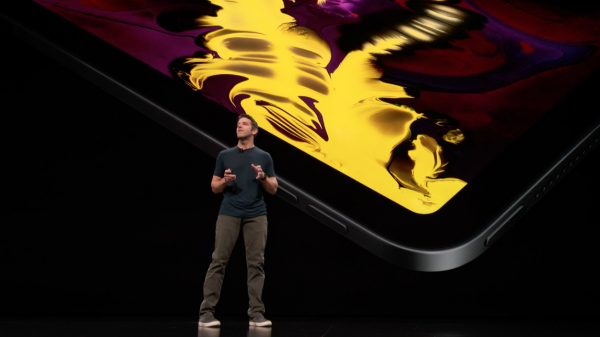
The product announcements at Tuesday’s event were, quite frankly, not interesting. Most importantly, the MacBook Air got some long-overdue upgrades — not before Apple CEO Tim Cook gave a winding speech about the 2008 original, saying, and I am not kidding, “When Steve [Jobs] pulled that MacBook Air out of that envelope [note: he pulled it out of one of those yellow “Classified” envelopes with the string closures, not sure why], it was clear that things would never be the same.” Fine.
The new Air weighs a quarter of a pound less than the previous one, comes in new colors, and, thanks to Apple’s metallurgy team, is now made entirely of recycled aluminum, which Brooklyn loved and cheered over for a full 30 seconds. This is another trademark of Apple events: inviting celebration of its accomplishments from the audience, which is a confusing mix of journalists (who should not be cheering) and developers (who can I guess do whatever they want) and ordinary people (I’d love to know how they are selected!).
Onlookers both physical and remote were told that the new MacBook Air was already available to preorder for $1,199: “Whether you’re a student, a writer, an entrepreneur, or simply new to Mac, we think you’re going to love it.” Cheer, cheer, etc.
Guests also cheered for the information that Apple has sold 400 million iPads, and that the new iPad Pro has a liquid retina display and a USB-C port. Shaan Pruden, senior director of developer relations at Apple, called it “a magical piece of glass that can be anything you need it to be.” She has been at the company since 1989, and Tuesday was the first time she ever appeared onstage.
Which brings us to some other standard aesthetic features of an Apple event:
Dark denim. On men.
Neutral sneakers. On men.
Blue shirts. On men.
Faces. Of men.
In fact, the number of women onstage in Brooklyn was so uncharacteristic for Apple that it was almost shocking. It confused my eye, like an AirPod. The women introduced new aesthetic choices to note — such as the fact that nearly all of them wore square-cut, collarless jackets or brightly colored blazers, occasionally long enough to suggest a lab coat.
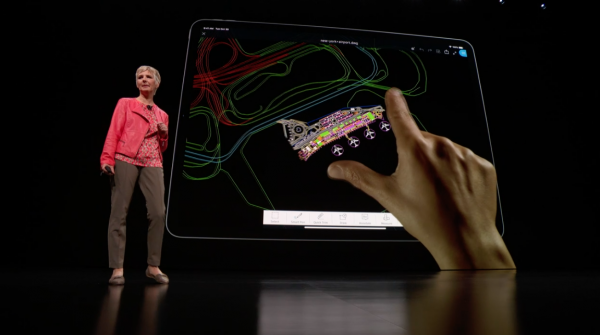
Angela Ahrendts, the former CEO of Burberry and current head of retail at Apple — also its highest-paid executive, reportedly making north of $24 million a year — took the stage in a sturdy-looking gray Burberry trench. The choice was either a wink at the uproar over the $2,900 pink lace Burberry trench she wore at her first Apple event last September or a revision meant to draw less attention from the real star objects of the show (computers, etc.).
In either case, the more controversial aspect of her 2017 keynote debut was her introduction of the Apple Store’s rebranding to Apple “Town Squares.” Rather than just places to buy things, they would now be places for community to happen — classes and hangouts and concerts. Most bizarrely, there was no preemptive defense of this as a ludicrous concept, seemingly no anticipation of a subsequent collective “huh?” (The Verge’s James Vincent, for one, called it “a pretentious farce,” writing that Apple had revealed a plan “to reconfigure civic life around itself and its ideals.”)
And Ahrendt announced Tuesday that Apple Stores around the world now host 18,000 “sessions” per week in photography, music, gaming, app development, and coding, and that they have already succeeded in becoming “gathering places where everyone is welcome.” New flagships have opened recently in Seattle and Thailand, to name a couple, and so has “one of our grandest forums in Europe, part of the creative renaissance in Paris.”
All the world is an art school and community center and corporate-monitored loitering zone run by Apple
“The architecture is the hardware, and the experiences inside the stores is our software,” Ahrendt explained. All the world, it is implied, is an art school and community center and corporate-monitored loitering zone run by Apple: a mall food court but sleeker and with no pretzels, and kids filming TikTok clips instead of smoking in the parking lot. It’s lucky for us in the midst of a “public space crisis.” Maybe you’ll forget to ask what happened to your community garden.
It’s fitting that Apple would move to this kind of IRL penning-in. The company’s product ecosystem is already, notoriously a “walled garden” — difficult for developers to play with, impossible for users to customize. Put simply: Once you have an Apple product, it is much easier to use everything else Apple makes than it is to use something it doesn’t. Apple Music works better with the iPhone than Spotify does. The new iPad Pro is powerful enough to charge a phone, but its ports are set up primarily for one phone in particular. And when I opened Safari to stream Tuesday’s event (the live stream only works in Apple’s proprietary browser!), I was immediately prompted to switch my default browser to Safari from Google Chrome, and had to opt out of a pre-checked box in the pop-up.
The Apple logo is not a Garden of Eden, tree of knowledge reference, despite popular myth. (It’s just an apple, with a bite taken out so that it can scale down without looking like a cherry.) Nevertheless, the aesthetics of an Apple event are extremely Old Testament — far less Sermon on the Mount and far more Moses and the burning bush. The room is dark, the camera is angled up from the speaker’s feet, and the default visuals are deserts (the new Mac OS is “Mojave”) and screens filled with churning lava.
Only Lana Del Rey, who gave a surprise performance at the end of the event, ended up looking small — alone and weird singing about nostalgia and heartbreak first thing in the morning. She introduced herself by saying she was not allowed to swear, which meant she was not allowed to promote her upcoming album Norman Fucking Rockwell; she was not allowed to refer to the song she performed (“Venice Bitch”) by name; and she was not allowed to sing the lyric “fresh out of fucks forever.” Instead, she said “fresh out of cares,” which is maybe the same thing but definitely not.
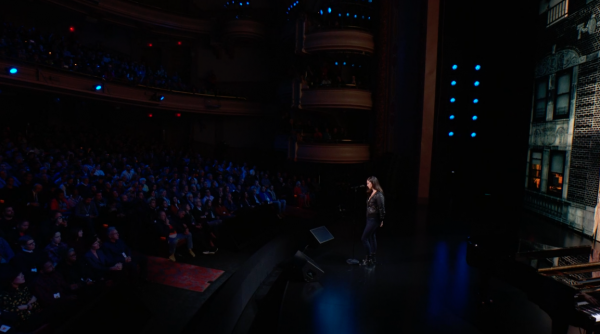
“We’re really honored to be performing for Apple,” she said, after hugging Tim Cook. “It’s really important to the way we make music, that we record, whether at home or in the studio.” It should not escape any of us that Lana Del Rey’s primary artistic interest for the bulk of her career has been embodying and thereby dissecting American iconography. Or that she does have an iPhone!
Steve Jobs used to trace his interest in functional, clean design back to the modernist tract houses in California’s 1950s working-class subdivisions — the simple, open, well-lit concrete and exposed-beamwork homes he grew up in, envisioned by Joseph Eichler. “Eichler did a great thing,” he told his biographer, Walter Isaacson. “His houses were smart and cheap and good. They brought clean design and simple taste to lower-income people. I love it when you can bring really great design and simple capability to something that doesn’t cost much. It was the original vision for Apple.”
In 2016, for the New York Times Magazine, Kyle Chayka wrote about “the oppressive gospel of minimalism” and the Silicon Valley elite’s interest in techno-asceticism, a kind of “Zen monkhood” in which people pare down their lives to the bare essentials — meaning, their sleek devices and nothing else. “Do I own the right things?” he asked. “Have I jettisoned enough of the wrong ones?” Thrown to Apple, those questions have an easy answer.
Jobs’s dream of a functional, affordable mass-market design has come true in that the iPhone, though it now costs more than $1,000, is not a luxury: It is all but necessary for effective participation in society. A MacBook is similarly not a luxury; it is standard-issue at colleges and workplaces, and owning one makes it much easier to use your iPhone. The new $799 iPad Pro is not a luxury either, VP of hardware engineering John Ternus argued on Tuesday — it’s as powerful as any laptop, and its 102 other-Apple-device-attracting magnets make it part of a “perfect system.”
But that’s not minimalism — not really, not at all. Apple, the company argues each time it appears in public, is sort of like your church, your school, your city, and your heart. It is simple, and functional, I guess, in that it puts everything about the human experience into the hands of one corporation. Very, very clean.
Sourse: breakingnews.ie
0.00 (0%) 0 votes


































